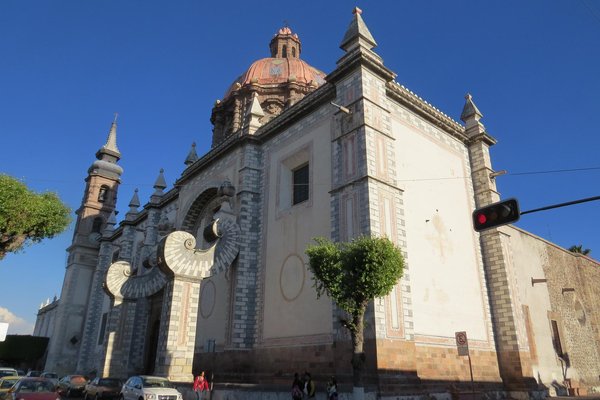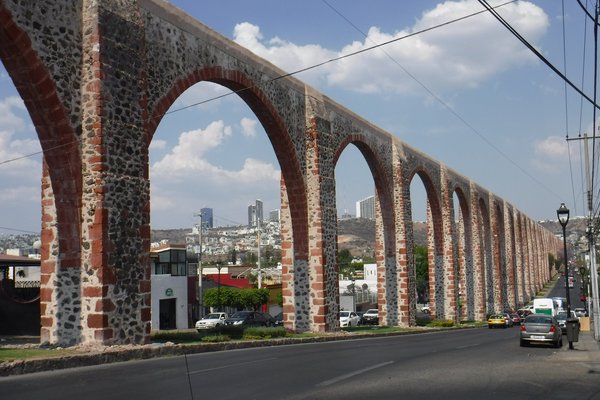Mexico
Querétaro
The Historic Monuments Zone of Querétaro comprises a well-preserved Spanish colonial town.
It has a specific 17th-century street plan and a number of 18th-century rich post-Baroque monuments. The layout of the town was split in two: a rectilinear street plan for the Spanish settlers, and small winding streets for the quarters of the indigenous population. The most prominent feature of the city is its enormous aqueduct.
Community Perspective: This is among the Mexican WH cities that reviewers enjoy the least. Highlights include the Santa Rosa de Viterbo church, the cloister of the Art Museum and the Aqueduct.
Site Info
Official Information
- Full Name
- Historic Monuments Zone of Querétaro (ID: 792)
- Country
- Mexico
- Status
-
Inscribed 1996
Site history
History of Querétaro
- 1996: Inscribed
- Inscribed
- Type
- Cultural
- Criteria
- ii
- iv
Links
- UNESCO
- whc.unesco.org
- Official
-
- visitmexico.com — Visit Mexico: Queretaro
All Links
UNESCO.org
- whc.unesco.org — whc.unesco.org/
Official Website
- visitmexico.com — Visit Mexico: Queretaro
Community Information
- Community Category
- Urban landscape: Colonial
Travel Information
Exact locations inscribed twice (or more)
Recent Connections
-
Perfect Inscriptions
1996 -
Creative Cities
DesignSee www.unesco.org
-
Reportedly haunted locations
"Casa de La Zacatecana: A colonial mans…
Connections of Querétaro
- Individual People
- Trivia
-
-
Built or owned by Spanish
The foundation date of Querétaro is pegged to 25 July 1531, which is when Spaniard Hernán Pérez Bocanegra y Córdoba arrived with the allied Otomi leader Conín (wiki) -
Minority communities
Indian quarters - Otomi, Tarasco and Chichimeca -
On Banknotes
Queretaro; 5 Peso; 1969 -
Reportedly haunted locations
"Casa de La Zacatecana: A colonial mansion in Santiago de Querétaro, Querétaro. In the 17th century, a woman known as 'La Zacatecana' commanded the murder of her husband, and then executed the killer that she contracted for the murder. The legend says that the mansion harbours three spirits."See en.wikipedia.org
-
- History
-
-
Places of Execution
Emperor Maximilian was executed in 1867 -
Treaties
1848 peace treaty with the USA, 1917 National Constitution
-
- Architecture
-
-
Churrigueresque
Santa Rosa de Viterbo -
Baroque
-
- World Heritage Process
-
-
WHC locations
Merida (1996) -
Perfect Inscriptions
1996 -
Exact locations inscribed twice (or more)
Also on Camino Real de Tierra Adentro
-
- Religion and Belief
-
-
Legends and Folk Myths
Chronicles of this event [the battle between the natives and the Spaniards], such as that written by Friar Isidro Félix de Espinoza, state that the natives were at the point of winning when a total eclipse of the sun occurred. This supposedly scared the natives and the Spanish claimed to have seen an image of Saint James (the patron saint of Spain) riding a white horse carrying a rose-colored cross. This event caused the natives to surrender. (Wiki)) -
Augustinian Order
Former monastery of St. Augustine, now the post office -
Dominican Order
Templo de Santo Domingo was founded by the Domincans -
Jesuit Order
Reales Colegios de San Ignacio y San Francisco Javier were both founded by the Jesuits. -
Franciscan Order
La Santa Cruz -
Cathedrals
Church of San Francisco served as a Cathedral until 1921 when it was chaged to San Felipe Neri. Both are within the WHS boundaries -
Sacred Mountains
Sangremal and which was called Ynlotepeque and considered sacred in pre-Hispanic times.
-
- Constructions
-
-
Monumental Fountains
Neptune's Fountain -
Aqueduct
-
Bandstand
at Jardín Zenea -
Theatres and Opera Houses
Teatro de la Republica
-
- WHS on Other Lists
-
-
Creative Cities
DesignSee www.unesco.org
-
Historic Civil Engineering Landmarks
For Water Supply and Control (Aqueduct)See www.asce.org
-
- Timeline
-
-
Built in the 17th century
"It is also endowed with a wealth of outstanding buildings, notably from the 17th and 18th centuries" and "It is the buildings erected du ring the economie heyday of the town in the last quarter of the 17th century which gave Querétaro its present-day appearance"
-
- WHS Hotspots
News
No news.
Recent Visitors
Visitors of Querétaro
- Alberto Rodriguez Gutierrez
- Alejandro Lau
- Alexander Barabanov
- Alexander Lehmann
- Alex Baranda
- Ana Lozano
- Anna Wludarska
- Argo
- arina_soboleva
- Atila Ege
- Bill Maurmann
- brendairala
- Carlo Sarion
- Carlos Sotelo
- Caspar
- Cheryl
- Christine
- Clyde
- Daniela Hohmann
- Delphine Delaunay
- Dimitar Krastev
- Don Irwin
- Els Slots
- Erik Jelinek
- Eva Kisgyorgy
- Fan Yibo
- Fede1203
- Feldhase
- Filip Murlak
- Francky D'Hoop
- Frédéric M
- GeorgeIng61
- giloudepuertorico
- Harry Mitsidis
- H Beswick
- headventure
- Hurrvinek
- Iain Jackson
- Ian Cade
- Ingemar Eriksson
- irosey
- Ivan Rucek
- Jana and Matt
- Janos
- Jarek Pokrzywnicki
- Javier
- Javier Coro
- Jay T
- Jean Lecaillon
- Jens
- jess4sythe
- João Aender
- Joel on the Road
- Jon Opol
- Kbooth
- Kevin McFarland
- Kim, Soo-youn
- Kurt Lauer
- Kyle Magnuson
- Lara Adler
- Lucas Del Puppo
- Ludvan
- Luis Filipe Gaspar
- Martina Rúčková
- Matthewsharris
- Michael Ayers
- Michael Novins
- Miguel Marquez
- Mihai Dascalu
- Mikko
- MMM
- MWaters66
- nan
- Niall Sclater
- Nihal Ege
- Petteri
- Philipp Peterer
- puessergio
- Randi Thomsen
- Reza
- Roger Ourset
- Roman Bruehwiler
- Sclowitz
- Sergio Arjona
- Shandos Cleaver
- sibariam
- Slavi
- sncjob
- Solivagant
- Stan
- Stanislaw Warwas
- Sutul
- Svein Elias
- Szucs Tamas
- Tamara Ratz
- Taotao Chen
- Thomas Buechler
- triath
- Van Hung
- Waters88
- Westwards
- Wojciech Fedoruk
- Xiquinho Silva
- ZCTLife
- zman5455
- Zoë Sheng
- Zos M
- ZZSong
Community Reviews
Show full reviews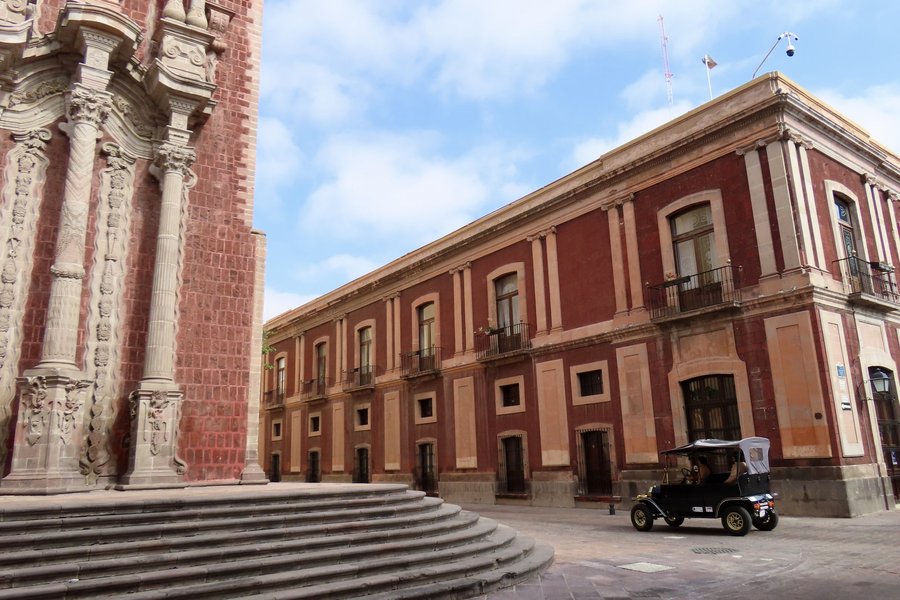
Querétaro does not exhibit the type of intact historic core as experienced in San Miguel de Allende and therefore is rightly or wrongly judged as inferior. As a visitor, I also preferred San Miguel de Allende overall, but I noticed something odd while reviewing pictures. I took a lot more pictures in Querétaro, because there are way MORE historic sites or monuments in Querétaro (258 ha) than compared with the relatively small historic centre of San Miguel de Allende (43 ha). More of something rarely means quality, but then I think of the Museo de Arte de Querétaro, the Aqueduct, and Santa Rosa de Viterbo Church, and more. Are these sites inferior to what I experienced in San Miguel de Allende? These are monumental, impressive historic properties. Yet, this is not all Querétaro has to offer. So, what exactly was not satisfying about Querétaro? I would name the primary issue is that plenty of the walking routes (maybe the majority) are unrewarding with too much electric wires and low unremarkable buildings. Therefore, I think the "royal street" axis should be emphasized as a key walking route across the city.
The Camino Real and Querétaro's Main Axis
Calle 5 De Mayo & Calle Francisco Madero make up the primary "Royal Street" that crosses the city and is identified in the Camino Real de Tierra Adentro map of Querétaro. While walking this road from East to West depending where you begin you will see mostly restaurants, bars, and galleries (some quite nice) …
Keep reading 0 comments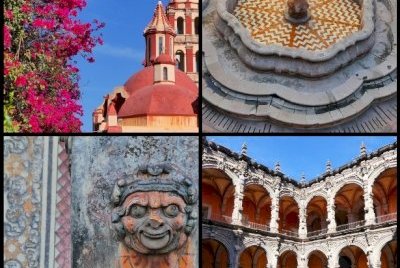
I visited this WHS in January 2022. Querétaro (note the accent on the second e for the correct pronunciation!) main peculiarity among the inscribed colonial towns or cities of Mexico is its layout which is practically split in two: a rectilinear street plan for the Spanish settlers and small winding streets for the quarters of the indigenous population.
From its "historic monuments zone" the definite highlights not to be missed in my opinion are the Church of Santa Rosa de Viterbo, the Church of Santa Cruz (together with the nearby mirador over the high aqueduct with modern high-rise buildings in the background), the Former Convent of St Augustine, the Casa de la Ecala and the Casa de la Marquesa. The absolute highlight not to be missed when visiting Querétaro is definitely the Church of Santa Rosa de Viterbo, with its outstanding over-the-top interior with three gilded altarpieces and a throne-like main chair, as well as the equally interesting Mexican colonial Baroque exterior with indigenous features.
The mirador over the high aqueduct is perhaps more enjoyable after sunset when the eyesore of the high-rise buildings in the background vanishes. Here there is a big UNESCO WHS plaque of the Camino Real, There's another one dedicated to the Camino Real near the traffic lights just opposite the Church of San Francis of Assisi. On the other hand, the UNESCO WHS plaque of Querétaro is on the side of the Palacio de Gobierno.
The former church and convent of St …
Keep reading 0 comments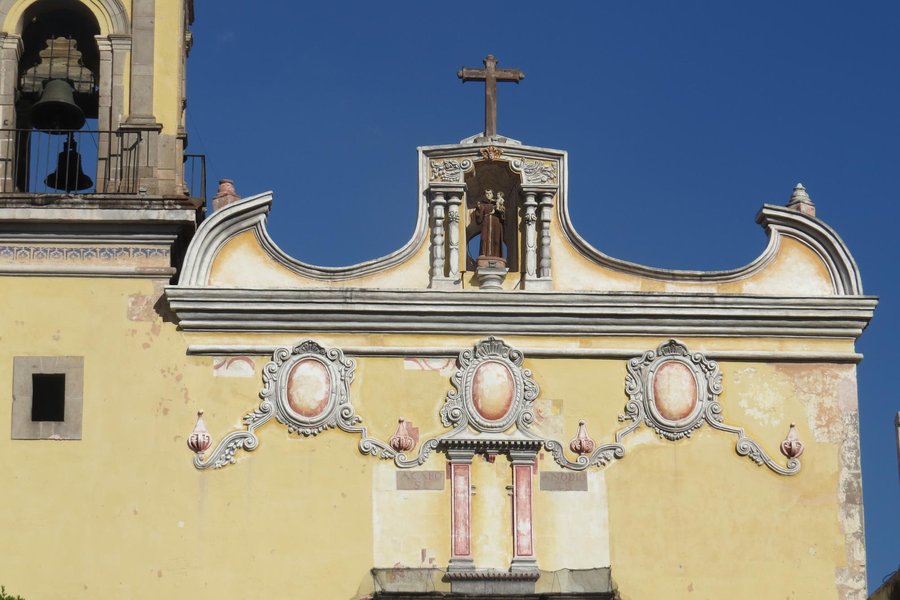
Time of visit: November 2021
Duration of visit: 3 hours
Mode of transportation: by rental car, from San Miguel de Allende en route to Puebla
Review and experience
Lovely historic centre and definitely one of the cleanest city cores we visited in our 3-week stays in central Mexico. To our surprise, having done very little research ahead of time, the overall city of Queretaro was surprisingly large and modern, with many skyscrapers in scattered around the city. The city core was a pleasant contrast to the modernity of the broader city. It was calm, quaint, and not particularly packed with foreign tourists that we had otherwise experienced in San Miguel de Allende.
That said, I completely agree with other reviewers perspective that this is among the weaker colonial towns in Mexico. Of 7 that I've visited to-date (Campeche, CDMX, SMA, Guanajuato, Oaxaca, Puebla, and Queretaro), Campeche and Queretaro were my least favorite. That said, I don't think it necessarily should be de-listed. For Queretaro, I imagine its OUV lies in the city's origin and the peaceful cohabitation of the Spanish and the indigenous. I'm taking this at face value, as I'm sure there was still lots of persecution of the indigenous population that took place here. While the architecture didn't feel different on the two sides, the layout of the urban core on Google Maps was very distinct. Furthermore, the convent at the Regional Museum was one of the most beautiful ones I had seen …
Keep reading 0 comments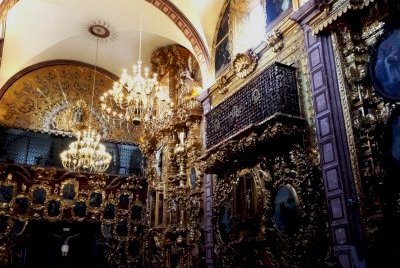
A common issue when interpreting Latin American colonial cities is that there is frequently no accessible frame of reference that fully explains each urban ensemble's value. Neither the travel guide books nor the tourism departments try too hard to communicate each destination beyond the dubious hyperbole (the biggest / tallest / oldest in the Americas) and the cliché (the indigenous influence / the local adaptation). After reading the reviews of Querétaro, I think that this city has suffered a lot from these superficial approaches.
If Querétaro were to be compared with any other colonial city, this would have to be Puebla. Both cities were the main centers of artistic experimentation and the main nodes of dissemination of Baroque culture in New Spain. Puebla during the 17th century and Querétaro during the 18th. However, while Puebla's area of influence included Oaxaca and Tlaxcala, the influence of Queretaro is evident in cities such as Guanajuato, San Luis Potosí and Salamanca. Although both traditions are encompassed within the term "baroque" they are completely different cultural expressions, produced by dissimilar societies. Puebla's Baroque is serious and devout, while Querétaro's is decadent and aristochratic.
Querétaro is characterized by the ingenuity of its architects in the construction of arches, of notable Islamic and Gothic heritage. During the Baroque period, there was no city in the Spanish Empire that experimented in such a way with polylobed arcades and mixtilineal doorways. The best examples are found in the Jesuit College and in the convents of …
Keep reading 0 comments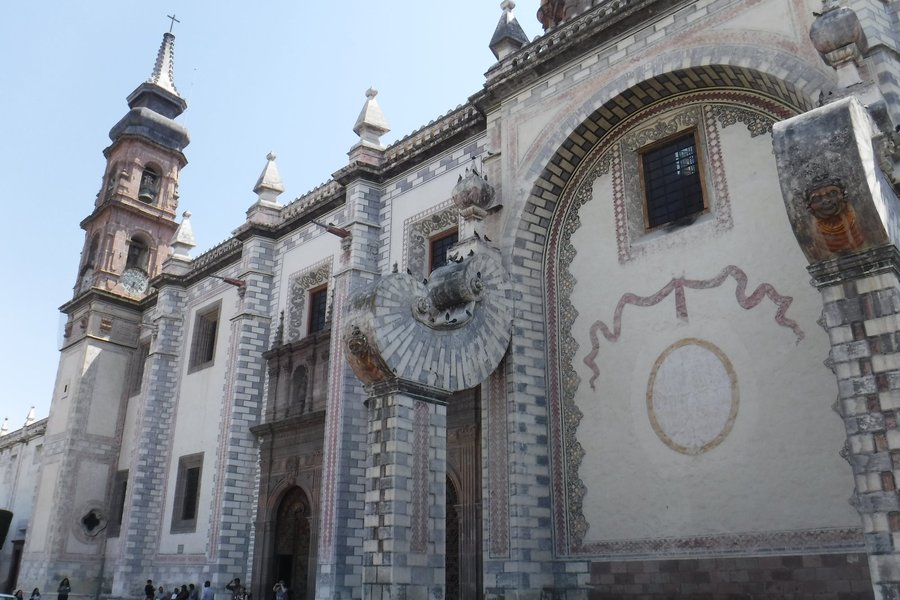
I visited Mexico between February and April 2019. I visited most WH colonial towns around Mexico City and Querétaro was the fourth one.
Querétaro is the most underwhelming town among Mexican WH cities and the one I enjoyed the least. It felt quite like every Mexican town to me, and I couldn't see the OUV. Monuments and churches in the center were either closed or boring, excepting maybe el Templo de Santa Rosa de Viterbo who as an interesting baroque exterior. Jardin Zenea and Plaza de la Constitucion were pleasant public squares, but doesn't deserve a stop in town by themselves. Under reviews bellow describe well my thoughts about Querétaro.
Otherwise, the most remarkable site (and the reason why this city deserved two instead of one star) is the aqueduct. It is gigantic and impressive (not Padre Tembleque level, but better than Morelia). It is 1,28 km long and has 74 highs arches. The view is particularly great from the mirador near el Mausoleo de la Corregidora.
Querétaro is conveniently located between San Miguel and Mexico City. You can also get here from Guadalajara, Morelia, Guanajuato, and San Luis Potosi. Former TWHS of Bernal is an easy day trip from here.
Keep reading 0 comments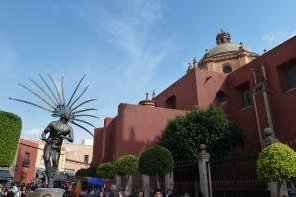
We only had a quick stop for lunch on New Year's Day 2015. As such there were a large amount of families out celebrating their day off. It leant the centre a really friendly and welcoming atmosphere but also meant the city's churches were closed.
As with other reviewers here the highlight was the weird church of Santa Rosa de Viterbo which seemed to show a quirky indigenous take on traditional European baroque architecture.
A stop in a cafe and a reviving empanada helped fuel us as we strolled around the pleasant squares dotted throughout the centre.
It provided a welcome break on our trip up the Camino Real and I think it would be a pleasant place to spend a bit more time.
[Site 6: Experience 7]
Keep reading 0 comments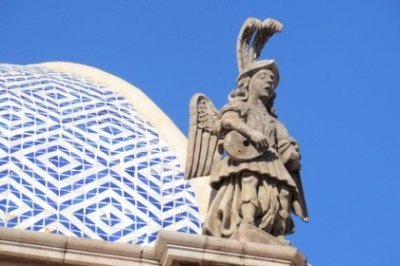
Queretaro I found the least interesting one among the Spanish-colonial cities of Central Mexico. It seems quite an affluent city though, probably nice enough to live in. I understand that it has quite a lot of people from Mexico City move there for better living circumstances.
If you're driving around Central Mexico hunting for WHS, Queretaro is a convenient stop and I spent one night here. Did my sightseeing in the afternoon - it took me two hours to find my way around the several tree-lined plazas and look at some churches. The nicest is the Santa Rosa de Viterbo: it has really weird, curved buttresses (see large photo above).
As we're working right now on a Top 50 Missing list on the Forum of this website (for sites that mysteriously haven't made it into the WH list yet), we could also introduce a Top 50 Removals: sites that have made it in when no one from an AB or the WHC seems to have been looking. Queretaro surely would get my vote for that list.
Keep reading 0 comments
Queretaro, beautifull city. When you talk about Queretaro, you are talking about one style. The baroche of Queretaro is different from others...maybe more exquisite, tasteful and deeper. Queretaro had been a baroche laboratory. Santa Rosa de Viterbo Churche is a great sample of that. One of the nicer buldings in Latin America is the San Agustin convent, today a museum. Divine......exquisite, refined.....
The waterduct with the colection of urban funtains give the city an especial atmosphere.
Keep reading 0 comments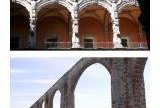
Queretaro undoubtedly has a pleasant city centre. Its calmness belies its situation at the heart of a growing conurbation of over 1 million people. That said, in terms of suitability for UNESCO inscription, I regard it as the “weakest” of the inscribed provincial historical cities in Central Mexico which we have seen. And (whilst not being the ultimate arbiter on such matters!) Michelin only grants it 2*, (together with Zacatecas and Morelia) compared with 3* for Guanajuato, Puebla and Oaxaca.
The “edge” which Queretaro claims over other Colonial “Centros historicos” lies (Quoting from the ICOMOS evaluation) in its being a “remarkably hybrid town”. We are told that “some commentators talk of a harmonious way of life or cohabitation between the 2 cultures”. Apparently 2 distinct layouts can be seen in the city’s plan – 20 blocks on the Spanish side of rectangular grid and 30 blocks on the indigenous side with curved and irregular streets! This, we are told, foreshadowed “the bicultural Mexico of today and the emergence of a new form of coexistence in the New World” Hmmmm? I am afraid I regard this as a lot of politically correct wishful thinking! I can see the slight differences in street layout on the map but, as we walked around, the distinction certainly didn’t herald any great change in atmosphere. In any case would it justify inscription even if it did?
The centre possesses a number of attractive buildings but Michelin identifies only 3 structures as justifying 2*.
a. The …
Keep reading 0 comments
